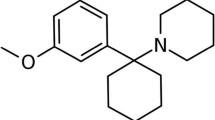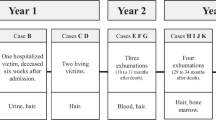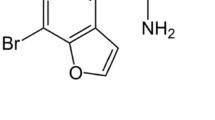Abstract
We report a fatal case of 3,4-methylenedioxypyrovalerone (MDPV) poisoning. A 35-year-old woman was taken to a nearby hospital after she was found unconscious. MDPV (1,200 ng/ml) and α-pyrrolidinobutiophenone (α-PBP; 200 ng/ml) were detected in her cardiac blood. Hair segments from the victim were also analyzed to confirm chronic drug use. MDPV and α-pyrrolidinovalerophenone (α-PVP) were found in many of the segments tested with the highest MDPV concentration at 22 ng/10-mm hair. We concluded that the woman died of acute MDPV poisoning, and that she had abused MDPV and α-PVP for a long time. To our knowledge, this is the first report dealing with MDPV in human hair segments, and with α-PBP in human specimens.


Similar content being viewed by others
References
Namera A, Nakamoto A, Saito T, Nagao M (2011) Colorimetric detection and chromatographic analysis of designer drugs in biological materials: a comprehensive review. Forensic Toxicol 29:1–24
Spiller HA, Ryan ML, Weston RG, Jansen J (2011) Clinical experience with and analytical confirmation of “bath salts” and “legal highs” (synthetic cathinones) in the United States. Clin Toxicol 49:499–505
Zaitsu K, Katagi M, Tatsuno M, Sato T, Tsuchihashi H, Suzuki K (2011) Recently abused β-keto derivatives of 3,4-methylenedioxyphenylalkylamines: a review of their metabolisms and toxicological analysis. Forensic Toxicol 29:73–84
Shanks KG, Dahn T, Behonick G, Terrell A (2012) Analysis of first and second generation legal highs for synthetic cannabinoids and synthetic stimulants by ultra-performance liquid chromatography and time of flight mass spectrometry. J Anal Toxicol 36:360–371
Uchiyama N, Kawamura M, Kikura-Hanajiri R, Goda Y (2012) Identification of two new-type synthetic cannabinoids, N-(1-adamantyl)-1-pentyl-1H-indole-3-carboxamide (APICA) and N-(1-adamantyl)-1-pentyl-1H-indazole-3-carboxamide (APINACA), and detection of five synthetic cannabinoids, AM-1220, AM-2233, AM-1241, CB-13 (CRA-13), and AM-1248, as designer drugs in illegal products. Forensic Toxicol 30:114–125
Kikura-Hanajiri R, Uchiyama N, Kawamura M, Goda Y (2012) Changes in the prevalence of synthetic cannabinoids and cathinone derivatives in Japan until early 2012. Forensic Toxicol 31:44–53
Kelly JP (2011) Cathinone derivatives: a review of their chemistry, pharmacology and toxicology. Drug Test Anal 3:439–453
Coppola M, Mondola R (2012) 3,4-Methylenedioxypyrovalerone (MDPV): chemistry, pharmacology and toxicology of a new designer drug of abuse marketed online. Toxicol Lett 208:12–15
Rosenbaum CD, Carreiro SP, Babu KM (2012) Here today, gone tomorrow…and back again? A review of herbal marijuana alternatives (K2, Spice), synthetic cathinones (bath salts), kratom, Salvia divinorum, methoxetamine, and piperazines. J Med Toxicol 8:15–32
Ross EA, Reisfield GM, Watson MC, Chronister CW, Goldberger BA (2012) Psychoactive “bath salts” intoxication with methylenedioxypyrovalerone. Am J Med 125:854–858
Wyman JF, Lavins ES, Engelhart D, Armstrong EJ, Snell KD, Boggs PD, Taylor SM, Norris RN, Miller FP (2013) Postmortem tissue distribution of MDPV following lethal intoxication by “bath salts”. J Anal Toxicol 37:182–185
Toennes SW, Harder S, Schramm M, Niess C, Kauert GF (2003) Pharmacokinetics of cathinone, cathine and norephedrine after the chewing of khat leaves. Br J Clin Pharmacol 56:125–130
Marinetti LJ, Antonides HM (2013) Analysis of synthetic cathinones commonly found in bath salts in human performance and postmortem toxicology: method development, drug distribution and interpretation of results. J Anal Toxicol 37:135–146
Berankova K, Habrdova V, Balikova M, Strejc P (2005) Methamphetamine in hair and interpretation of forensic findings in a fatal case. Forensic Sci Int 153:93–97
Miki A, Katagi M, Shima N, Kamata H, Tatsuno M, Nakanishi T, Tsuchihashi H, Takubo T, Suzuki K (2011) Imaging of methamphetamine incorporated into hair by MALDI-TOF mass spectrometry. Forensic Toxicol 29:111–116
Wada M, Sugimoto Y, Crabtree BL, Evans C, Montgomery JH, Ikeda R, Kuroda N, Nakashima K (2013) Simultaneous determination of amphetamine-type stimulants in abusers’ hair: clinical usefulness of hair analysis in prehospitalization for abusers. Forensic Toxicol 31:2–8
Nishida M, Namera A, Yashiki M, Kojima T (2003) Routine analysis of amphetamine and methamphetamine in biological materials by gas chromatography–mass spectrometry and on-column derivatization. J Chromatogr B 789:65–71
Saito T, Namera A, Osawa M, Aoki H, Inokuchi S (2013) SPME–GC–MS analysis of α-pyrrolidinovalerophenone in blood in a fatal poisoning case. Forensic Toxicol. doi:10.1007/s11419-013-0183-8
Strano-Rossi S, Bermejo-Barrera A, Chiarotti M (1995) Segmental hair analysis for cocaine and heroin abuse determination. Forensic Sci Int 70:211–216
Kintz P, Villain M, Cirimele V (2006) Hair analysis for drug detection. Ther Drug Monit 28:442–446
Nishida M, Yashiki M, Namera A, Kimura K (2006) Single hair analysis of methamphetamine and amphetamine by solid phase microextraction coupled with in matrix derivatization. J Chromatogr B 842:106–110
Jurado C, Kintz P, Menéndez M, Repetto M (1997) Influence of the cosmetic treatment of hair on drug testing. Int J Legal Med 110:159–163
Wennig R (2000) Potential problems with the interpretation of hair analysis results. Forensic Sci Int 107:5–12
Kriikku P, Wilhelm L, Schwarz O, Rintatalo J (2011) New designer drug of abuse: 3,4-methylenedioxypyrovalerone (MDPV). Findings from apprehended drivers in Finland. Forensic Sci Int 210:195–200
Swortwood MJ, Boland DM, DeCaprio AP (2013) Determination of 32 cathinone derivatives and other designer drugs in serum by comprehensive LC–QQQ–MS/MS analysis. Anal Bioanal Chem 405:1383–1397
Conflict of interest
There are no financial or other relations that could lead to a conflict of interest.
Author information
Authors and Affiliations
Corresponding author
Rights and permissions
About this article
Cite this article
Namera, A., Urabe, S., Saito, T. et al. A fatal case of 3,4-methylenedioxypyrovalerone poisoning: coexistence of α-pyrrolidinobutiophenone and α-pyrrolidinovalerophenone in blood and/or hair. Forensic Toxicol 31, 338–343 (2013). https://doi.org/10.1007/s11419-013-0192-7
Received:
Accepted:
Published:
Issue Date:
DOI: https://doi.org/10.1007/s11419-013-0192-7




